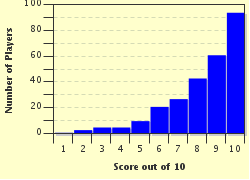Quiz Answer Key and Fun Facts
1. The skull and crossbones flag comprises a human skull set above two crossed bones in white set against a black background, and is synonymous with pirate ships. What is the popular name by which this piratical flag is generally known?
2. Which Scottish mathematician and physicist, who was born in 1550 and whose name is also linked to logarithms, invented a counting frame named after him known as '______'s Bones'?
3. Which female private detective is the main character and protagonist in P D James's book 'The Skull Beneath the Skin'?
4. Which 'space-themed' name refers to the cavities in the skull which contain the eyes?
5. Which character in the 'Star Trek' series goes by the nickname of 'Bones'?
6. A homophone of 'skull', in which Olympic sport would you encounter the term 'sculling'?
7. The femur, or thigh bone, is the longest bone in the human body. On the opposite end of the size spectrum, where would you find the smallest?
8. In the 'Harry Potter' books by J K Rowling, the 'Dark Mark' used by Lord Voldemort and his Death Eaters is not a skull and crossbones, but the mark of a human skull with which additional feature conjuring up terror when seen?
9. Another 'skull' homophone for you. What sort of activity would you expect to find going on in a room known as a scullery?
10. Which famous film monster made his first appearance on the big screen in 1933 in a film starring Fay Wray as aspiring actress Ann Darrow, set on the fictional and mysterious Skull Island?
Source: Author
Jennifer5
This quiz was reviewed by FunTrivia editor
Snowman before going online.
Any errors found in FunTrivia content are routinely corrected through our feedback system.

